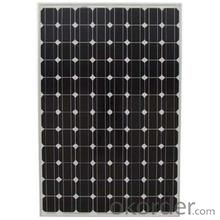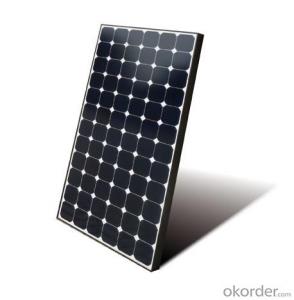CNBM On Grid System 5000W with Certificate UL TUV CE
- Loading Port:
- Shanghai
- Payment Terms:
- TT OR LC
- Min Order Qty:
- 100 watt
- Supply Capability:
- 1000 watt/month
OKorder Service Pledge
OKorder Financial Service
You Might Also Like
Item specifice
CNBM On Grid System 5000W with Certificate UL TUV CE
Product description
They range from small residential and commercial rooftop systems to large utility-scale solar power stations. Unlike stand-alone power systems, a grid-connected system rarely includes an integrated battery solution, as they are still very expensive. When conditions are right, the grid-connected PV system supplies the excess power, beyond consumption by the connected load, to the utility grid.
Connection of the photovoltaic power system can be done only through an interconnection agreement between the consumer and the utility company. The agreement details the various safety standards to be followed during the connection.[4]
Systems such as Net Metering and Feed-in Tariff which are offered by some system operators, can offset a customers electricity usage costs. In some locations though, grid technologies cannot cope with distributed generation feeding into the grid, so the export of surplus electricity is not possible and that surplus is earthed.
Grid-connected PV systems are comparatively easier to install as they do not require a battery system.[1][6]
Grid interconnection of photovoltaic (PV) power generation systems has the advantage of effective utilization of generated power because there are no storage losses involved.[7]
Grid-connected PV can cause issues with voltage regulation. The traditional grid operates under the assumption of one-way, or radial, flow. But electricity injected into the grid increases voltage, and can drive levels outside the acceptable bandwidth of ±5%.[8]
Grid-connected PV can compromise power quality. PV’s intermittent nature means rapid changes in voltage. This not only wears out voltage regulators due to frequent adjusting, but also can result in voltage flicker.[9]
Connecting to the grid poses many protection-related challenges. In addition to islanding, as mentioned above, too high levels of grid-connected PV result in problems like relay desensitization, nuisance tripping, interference with automatic reclosers, and ferroresonance.[10]

Application
Industrial
Commercial
Residential
Feature
Residential, grid-connected rooftop systems which have a capacity more than 10 kilowatts can meet the load of most consumers.[2] They can feed excess power to the grid where it is consumed by other users. The feedback is done through a meter to monitor power transferred. Photovoltaic wattage may be less than average consumption, in which case the consumer will continue to purchase grid energy, but a lesser amount than previously. If photovoltaic wattage substantially exceeds average consumption, the energy produced by the panels will be much in excess of the demand. In this case, the excess power can yield revenue by selling it to the grid. Depending on their agreement with their local grid energy company, the consumer only needs to pay the cost of electricity consumed less the value of electricity generated. This will be a negative number if more electricity is generated than consumed.[3] Additionally, in some cases, cash incentives are paid from the grid operator to the consumer.
Packaging
With carton and box
- Q:What are the economic benefits of using solar energy systems?
- The economic benefits of using solar energy systems include reduced energy costs, long-term savings, job creation, and increased local investment. Solar energy systems can significantly lower electricity bills by generating electricity from the sun, reducing reliance on traditional energy sources. Additionally, the long lifespan of solar panels allows for long-term savings as they require minimal maintenance and have no fuel costs. The growing demand for solar energy also creates new job opportunities in the installation, manufacturing, and maintenance sectors. Moreover, investing in solar energy systems stimulates local economies by keeping energy spending within the community and reducing reliance on imported energy sources. Overall, the economic benefits of using solar energy systems contribute to sustainability, cost-effectiveness, and the growth of green industries.
- Q:How do solar energy systems impact the reduction of greenhouse gas emissions?
- Solar energy systems have a significant impact on the reduction of greenhouse gas emissions. Unlike fossil fuels, solar energy systems produce electricity without emitting any greenhouse gases such as carbon dioxide (CO2) or methane (CH4) during operation. This is because solar panels harness the sun's energy to generate electricity, which is a clean and renewable source of power. By replacing traditional energy sources like coal or natural gas, solar energy systems mitigate the need for burning fossil fuels, which are the primary sources of greenhouse gas emissions. Fossil fuels release vast amounts of CO2 and other pollutants into the atmosphere when burned for electricity generation. In contrast, solar energy is generated through photovoltaic (PV) panels or solar thermal collectors, which do not produce any emissions. Moreover, solar energy systems can also indirectly contribute to reducing greenhouse gas emissions. When solar power is integrated into the electricity grid, it helps to displace electricity generated from fossil fuel power plants. This displacement reduces the overall demand for fossil fuels, leading to a decrease in greenhouse gas emissions from the power sector. Furthermore, solar energy systems can be deployed on a wide range of scales, from small residential installations to large utility-scale solar farms. This versatility allows solar power to be harnessed in both urban and rural areas, providing clean energy solutions to diverse communities. By encouraging the adoption of solar energy systems, governments and organizations can accelerate the transition to a low-carbon economy and mitigate the harmful effects of climate change. In conclusion, solar energy systems play a crucial role in reducing greenhouse gas emissions by producing clean electricity without any emissions during operation. By displacing fossil fuel-based electricity generation and promoting the use of renewable energy, solar power contributes significantly to mitigating climate change and creating a sustainable future.
- Q:How does the efficiency of solar panels vary across different temperatures?
- The efficiency of solar panels typically decreases as the temperature increases.
- Q:Can solar energy systems be used in cold storage facilities?
- Yes, solar energy systems can be used in cold storage facilities. Solar panels can generate electricity to power the refrigeration systems required for cold storage. However, it is important to design the system with proper insulation and backup power options to ensure continuous operation during periods of low sunlight or high energy demand.
- Q:How does the efficiency of solar panels vary across different installation locations?
- The efficiency of solar panels varies across different installation locations due to various factors such as the amount of sunlight received, the angle and orientation of the panels, shading, temperature, and local weather conditions.
- Q:Can solar energy systems be used in conjunction with other renewable energy sources?
- Yes, solar energy systems can definitely be used in conjunction with other renewable energy sources. This approach, known as hybrid renewable energy systems, allows for a more reliable and efficient power generation. By combining solar energy with sources like wind, hydro, or biomass, we can overcome the intermittent nature of solar power and ensure a continuous supply of clean energy. This combination also provides a more balanced and sustainable energy mix, reducing dependency on a single source and maximizing the overall renewable energy potential.
- Q:Can solar energy systems be used for powering electric gates or fences?
- Yes, solar energy systems can be used to power electric gates or fences. Solar panels can generate electricity from sunlight, which can be stored in batteries and used to power the gates or fences. This provides a sustainable and cost-effective solution for powering these systems.
- Q:How does a solar thermal system use sunlight to heat water or air?
- A solar thermal system uses sunlight to heat water or air by using solar collectors, typically consisting of flat panels or evacuated tubes, which absorb the sun's energy. The collectors are designed to maximize the absorption of sunlight and convert it into heat. Inside the collectors, there are pipes or tubes containing a heat transfer fluid, such as water or antifreeze, which is heated as it circulates through the collectors. This heated fluid is then used to transfer the heat to a storage tank where it can be used for hot water supply or circulated through a heat exchanger to warm air in a building. Overall, the solar thermal system harnesses the sun's energy to directly heat the water or air, providing a sustainable and renewable source of thermal energy.
- Q:Are there any disadvantages to installing a solar energy system?
- Yes, there are a few disadvantages to installing a solar energy system. Some of the main drawbacks include the high upfront cost of installation, the need for sufficient sunlight to generate optimal power, and the requirement for ample space to accommodate the solar panels. Additionally, solar energy systems can be less efficient during cloudy or rainy periods, and their production may not align with peak energy demands. Finally, the maintenance and occasional replacement of components can be costly and time-consuming. Despite these disadvantages, the long-term benefits and environmental advantages of solar energy make it an increasingly popular and viable option for many households and businesses.
- Q:Can solar energy systems be used in powering electric fences or security systems?
- Yes, solar energy systems can certainly be used in powering electric fences or security systems. Solar panels can generate electricity by converting sunlight into energy, which can then be stored in batteries or used directly to power various devices. This makes solar energy systems a practical and sustainable choice for powering electric fences or security systems, especially in remote or off-grid locations where traditional power sources may be unavailable or unreliable. Solar-powered electric fences can effectively deter intruders or keep animals within a designated area, while solar-powered security systems can provide continuous surveillance and monitoring without the need for a constant supply of electricity. Additionally, solar energy systems are environmentally friendly and can help reduce carbon emissions associated with conventional power sources, making them an increasingly popular and cost-effective solution for powering various applications, including electric fences and security systems.
1. Manufacturer Overview |
|
|---|---|
| Location | |
| Year Established | |
| Annual Output Value | |
| Main Markets | |
| Company Certifications | |
2. Manufacturer Certificates |
|
|---|---|
| a) Certification Name | |
| Range | |
| Reference | |
| Validity Period | |
3. Manufacturer Capability |
|
|---|---|
| a)Trade Capacity | |
| Nearest Port | |
| Export Percentage | |
| No.of Employees in Trade Department | |
| Language Spoken: | |
| b)Factory Information | |
| Factory Size: | |
| No. of Production Lines | |
| Contract Manufacturing | |
| Product Price Range | |
Send your message to us
CNBM On Grid System 5000W with Certificate UL TUV CE
- Loading Port:
- Shanghai
- Payment Terms:
- TT OR LC
- Min Order Qty:
- 100 watt
- Supply Capability:
- 1000 watt/month
OKorder Service Pledge
OKorder Financial Service
Similar products
New products
Hot products
Related keywords



























